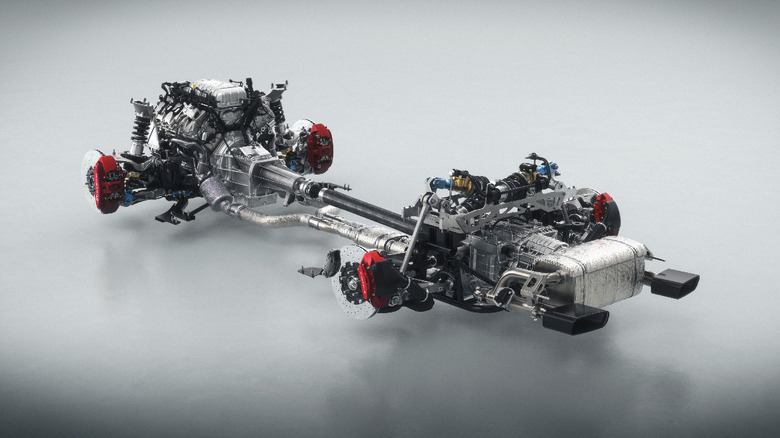A Closer Look At The Supercharged 5.2L V8 Engine That Powers The Ford Mustang GTD
The Ford Mustang was an instant hit upon its release in 1964, despite having an anemic straight six engine as its base powerplant. Two years later, the engines that powered the 1966 Mustang included a bigger I6 and three 289 cubic-inch V8s, with a high-performance model that made 271 horsepower. As the Mustang evolved over the years, its engines got bigger and beefier. The Coyote 5.0-liter V8 is one of the best V8s ever made and first showed up in the 2011 Mustang GT, but many purists stomped their hooves when Ford went electric with the 2021 Mustang Mach-e. The flared nostrils of those loyalists should be relaxing with the latest news from Ford's Dearborn, Michigan headquarters, though.
Ford just unveiled the 2025 Mustang GTD. The car has been in development since 2021 alongside the GT3, which will run at next year's 24 Hours of LeMans — motorsport's greatest race. The Mustang GTD was bred for the track but built for public roads, although it will have a price tag of over $300,000. At its heart sits a supercharged 5.2-liter V8 capable of producing more than 800 horsepower — eight times more than the first Mustang.
The GTD's V8 is an updated version of the engine that powered the soon-to-be-extinct Shelby GT500, tuned to produce about 40 more ponies for the newest pony car. That engine is paired with an eight-speed transaxle to help balance the car front-to-rear, and the rear suspension was updated to manage the weight transfer that 800 angry horses will bring to the chassis.
The Mustang GTD will be out later this year or sometime in 2025
Ford equipped all four corners of the $300,000 Mustang GTD with motorized dampers to further control the V8's fury, and the trunk space is dedicated to a transaxle cooler with air scoops at the front of the rear fenders. There's still room for groceries, though, as Ford ditched the rear seat to allow for limited cargo space. The use of a transaxle also makes room for another Mustang first; the reservoir for the V8's dry-sump lubrication system will sit in the spot where Ford has traditionally mounted the Mustang's transmission. The engine will sing through an Akrapovic titanium-valve exhaust system with twin rectangular tips in the rear bumper, and it will be supplied with air in front via a mesh air dam and vents in the hood and front quarter panels.
It's not quite time to take a second mortgage on your house and hustle to your local Ford dealer, though. The Mustang GTD won't be available until later this year or sometime in 2025, and Ford will only be making about 1,000 of them. If you are one of the lucky buyers who secures one, you'll get an engine that has over 300 horsepower more than the one in Ford's GT3 LeMans racer.
Much of the GTD is made of carbon fiber
To send power from the engine to the transaxle, Ford is using a carbon-fiber driveshaft in the GTD. This will help keep the car's weight down and handle the engine's 7,500 rpm redline. Much of the GTD's body is made of the high-strength, lightweight material as well, and buyers can opt for a carbon-fiber chassis tray to shed a few more pounds. That add-on comes in a package with hydraulic flaps that manage airflow through the underbody to add downforce. This technology violates IMSA regulations and can't be used on the GT3.
The GTD's design invokes that of a Porsche 911 with its enormous whale tail, and the optional aerodynamics package makes the rear wing responsive to driving conditions via hydraulic actuators in the C-pillar. Ford hasn't yet sent us a GTD to put through the paces, so we don't have performance numbers to share at this time. As soon as we get our driving gloves on one and wipe the smiles off our faces, we'll share those figures with you.
The Mustang GTD borrows parts from the F-22 fighter jet
Although the Mustang GTD hasn't been track-tested yet, Ford is promising some staggering benchmarks. "The target for this project was clear – go much, much faster than we've ever gone before with a targeted sub-7-minute Nürburgring time," chief program engineer Greg Goodall said in a press release. "This makes it the fastest roadgoing Mustang ever from Ford." Ford Performance Motorsports global director Mark Rushbrook added that the GTD's engine and transaxle were developed in tandem with the aero package and body to maximize its performance. "What makes it go is even more compelling than what you can see when it passes you by," he said. "When you look at the engineering, the aerodynamics, how the powertrain works, the Mustang GTD is a rocketship for the road."
To keep that rocket ship firmly planted to the road surface, Ford will outfit the Mustang GTD with wide tires and variable traction control. You'll be kept secure in the Recaro racing seat and enjoy the tactile sensation of operating the optional titanium paddle shifters and rotary dial shifter, which are made from pieces of a decommissioned F-22 fighter jet.



